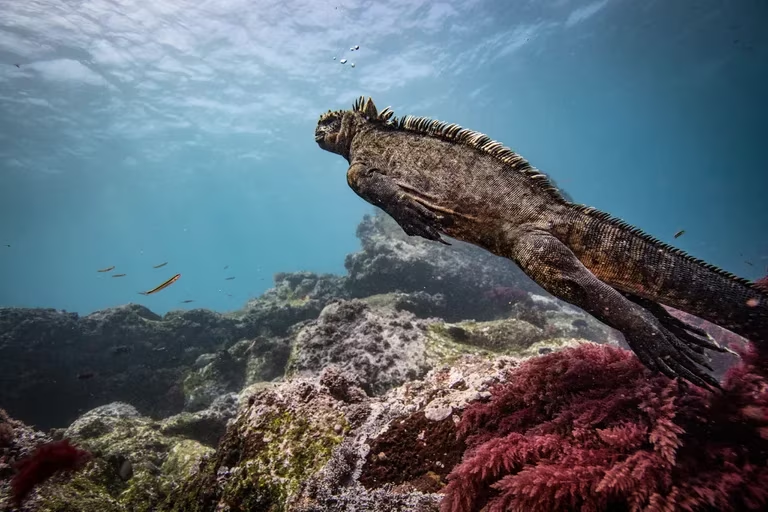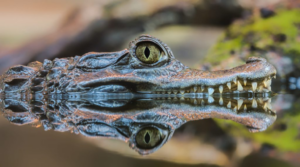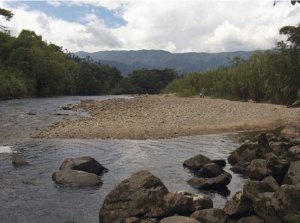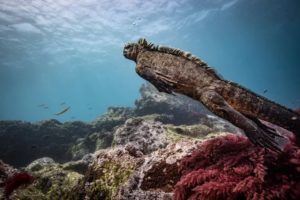The Galapagos Islands are home to some of the most extraordinary creatures on Earth, and among them, marine iguanas stand out as true marvels of evolution. These fascinating reptiles have captured the attention of scientists and nature enthusiasts alike. From their intriguing physiological adaptations to their critical role in Charles Darwin’s theory of evolution, marine iguanas are a species worth exploring.
Characteristics of Marine Iguanas
The marine iguana can measure up to 1.5 metres and lives 5-12 years. It features a robust body formed by a series of scales and small spines that become more prominent in the dorsal area and head. It also has sharp claws that allow it to quickly get out of the water, despite the forces of the tides in this area of South America. Its tail is flattened and it swims moving its body in an undulating and lateral way.
The Ever-Changing Colors of Marine Iguanas
The marine iguana’s body colouration is a sight to behold. Ranging from black to light grey, this unique characteristic allows the iguanas to regulate their body heat effectively after emerging from the cool ocean waters. Adult males, however, exhibit a mesmerising transformation throughout the seasons. The species found in the South Islands showcases greenish and reddish hues, while those inhabiting Santa Cruz Island boast black and reddish tones. The iguanas of Fernandina Island, on the other hand, display dark greenish and brick shades. Juveniles, in contrast, exhibit a relatively light dorsal stripe.
Unveiling the Herbivorous Nature of Marine Iguanas
While their sharp claws may give the impression of ferocious predators, marine iguanas are, in fact, herbivores. Their diet primarily consists of nutrient-rich seaweed, and the ocean serves as their main source of sustenance. The unique shape of their mouth is a remarkable adaptation that enables them to feed on algae, while their claws serve the purpose of securing a firm grip to prevent the ocean currents from dislodging them during feeding.
Masters of the Sea: Expert Swimmers
Marine iguanas are exceptional swimmers, equipped with specialised toe membranes that enhance their aquatic prowess. They can dive as deep as 25 metres and are able to stay up to 60 minutes underwater. Experts suggest that these remarkable reptiles share a common ancestor with their land-dwelling counterparts, an evolutionary adaptation that allows them to navigate the ocean with ease. However, when on land, they tend to exhibit a somewhat clumsy demeanour.
The Mating Rituals of Marine Iguanas
Reproduction in marine iguanas follows an oviparous method, whereby the females lay eggs to bring forth the next generation. Surprisingly, these iguanas share a common trait with humans – the importance of scent during the mating process. Female iguanas select males with the most appealing scent, which plays a crucial role in their mating ritual. Moreover, males utilise vibrant skin colours as an additional strategy to attract potential mates.
Habitat, Feeding Habits, and Territorial Nature
Marine iguanas primarily inhabit coastal regions on the islands of Isabela, Fernandina, Española, Floreana and Santa Cruz, where they feast on marine plants and algae. Despite their robust bodies and imposing claws, these creatures do not consume meat. In times of scarcity, they readily adapt and consume terrestrial plants without any issue. These reptiles exhibit a territorial nature, fiercely guarding their living spaces as a means of ensuring their survival. While males tolerate the presence of females, sufficient food availability determines their acceptance.
A Cooperative Relationship and Ongoing Threats
Nighttime offers a fascinating spectacle as Darwin’s finches and iguanas engage in cooperative behaviour. The iguanas stretch their bodies, allowing the finches to remove ticks, thus forming a mutually beneficial relationship. However, the survival of this species is under constant threat. Human activities, including the presence of feral cats and dogs, pose a significant danger to their population. Moreover, the marine iguanas face additional challenges due to their constant interaction with the marine environment. Many of them become entangled in fishing nets, causing harm and even death. The accumulation of plastic debris on the beaches also poses a grave danger to their well-being.
The Scientific Significance of Marine Iguanas
The marine iguanas hold a special place in the realm of scientific research. These reptiles have become a phenomenal laboratory for scientists to study the process of speciation. With seven distinct subspecies spread across remote territories, marine iguanas can still reproduce with each other, shedding light on the intricacies of evolution and adaptation.
Marvels of Nature: Respecting and Protecting the Marine Iguanas
In the past, renowned naturalist Charles Darwin referred to this species as “clumsy and disgusting”. However, with our current understanding of the marine iguanas’ remarkable characteristics, it is evident that these reptiles are truly captivating creatures. They possess a wealth of interesting and uncommon traits that make them a unique and invaluable species, deserving of our utmost respect and protection.





